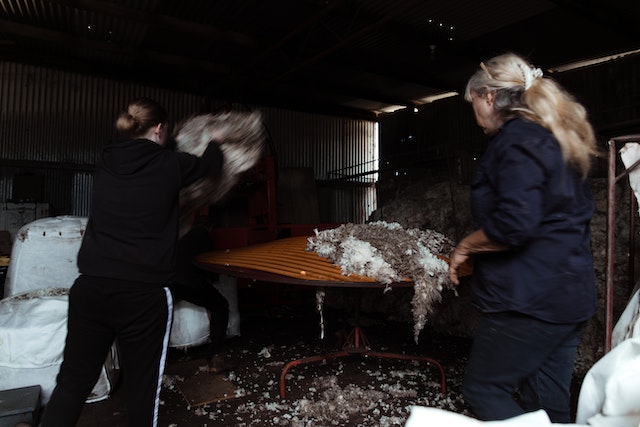How Agricultural Workwear Can Improve Productivity on the Farm

Agricultural workwear is an essential aspect of farming and agriculture. Farmers and agricultural workers face a wide range of hazards in the field, including sharp tools, machinery, chemicals, and harsh weather conditions. The right workwear can provide protection from these hazards, while also improving comfort, mobility, and productivity.
Agricultural workwear includes a variety of items such as coveralls, boots, gloves, hats, and safety glasses, each designed to meet specific safety standards and regulations. Choosing the appropriate workwear for the job can help reduce the risk of accidents and injuries, improve the safety of workers, and ultimately enhance the quality and quantity of work done on the farm. In this context, agricultural workwear plays a crucial role in ensuring the safety and well-being of workers in the field, as well as in the overall success of farming operations.
Choosing the right agricultural workwear involves considering a range of factors, such as the type of work being done, the climate and weather conditions, and any applicable safety regulations. For example, workwear designed for hot and humid climates may be made of lightweight, breathable materials that allow workers to stay cool and dry, while workwear for colder climates may have insulation and waterproof features to keep workers warm and dry.
Moreover, as sustainability becomes increasingly important in agriculture, more companies are developing eco-friendly workwear options made from organic cotton or recycled materials. Sustainable workwear not only reduces environmental impact, but also promotes social responsibility in the supply chain.
Why is agricultural workwear important?
Agricultural workwear is an important aspect of farming and agriculture. It provides crucial protection to farmers and agricultural workers from various hazards present in the field, such as sharp tools, machinery, chemicals, and harsh weather conditions. This protection helps to minimize the risk of injuries and accidents, which can lead to lost productivity and increased costs.

In addition to protection, agricultural workwear also improves comfort and mobility, allowing workers to move freely and perform tasks more efficiently. It also plays an essential role in ensuring compliance with safety standards and regulations, contributing to the overall safety and well-being of workers in the field. Job satisfaction is also increased when workers feel safe and comfortable in their workwear, leading to higher quality and more efficient work. Therefore, agricultural workwear is essential for the safety, productivity, and success of farming operations, promoting a sustainable and successful agriculture industry.
Furthermore, the importance of agricultural workwear goes beyond just the safety and comfort of workers. It also has a significant impact on the overall success and sustainability of farming operations. For instance, by reducing the risk of accidents and injuries, farmers can avoid the costs associated with lost productivity and medical expenses. Additionally, agricultural workwear can improve the efficiency and quality of work done on the farm by allowing workers to move freely and perform tasks more effectively. This can ultimately lead to increased profitability and long-term sustainability for farming operations.
How can agricultural workwear improve productivity on the farm?
Agricultural workwear can have a significant impact on productivity on the farm. The right workwear can improve the efficiency and speed at which tasks are completed, ultimately contributing to increased productivity. Firstly, by providing workers with the appropriate workwear, they can feel more comfortable and at ease while working. The right workwear can improve mobility, allowing workers to move around and perform tasks more efficiently, reducing the time and effort needed to complete tasks. This can have a significant impact on productivity, allowing workers to complete tasks faster and with less fatigue.
Secondly, agricultural workwear provides protection to farmers and workers from various hazards present in the field. This protection helps to reduce the risk of accidents and injuries, allowing workers to focus on their tasks without having to worry about their safety. By reducing the risk of accidents and injuries, workers are less likely to experience delays and disruptions in their work, contributing to increased productivity.
Overall, agricultural workwear is essential for improving productivity on the farm. By providing workers with the right workwear, they can feel comfortable and protected, allowing them to perform tasks more efficiently and safely. The right workwear can reduce fatigue, speed up the completion of tasks, and improve the overall working conditions, all of which contribute to increased productivity on the farm.
What are the benefits of using agricultural workwear?
There are several benefits of using agricultural workwear in farming and agriculture. Firstly, agricultural workwear provides protection to farmers and workers from various hazards in the field, such as sharp tools, machinery, and harsh weather conditions. This protection helps to minimize the risk of accidents and injuries, contributing to a safer working environment.
Secondly, agricultural workwear can improve comfort and mobility, allowing workers to move freely and perform tasks more efficiently. This can lead to improved productivity and quality of work, ultimately contributing to the success and sustainability of farming operations.
Thirdly, workwear plays a crucial role in ensuring compliance with safety standards and regulations, promoting the safety and well-being of workers in the field. Compliance with safety regulations can help to prevent penalties and fines, ultimately contributing to the financial stability and success of farming operations.
Finally, the use of appropriate workwear can improve job satisfaction and morale among workers, leading to higher quality and more efficient work. This can contribute to the long-term success and sustainability of farming operations by reducing turnover rates and improving overall job performance.
What are the different types of agricultural workwear?
There are various types of workwear available to farmers and workers, each designed to provide specific benefits and protection. One of the most common types of agricultural workwear is coveralls, which are made from durable materials and provide full-body protection from hazards in the field. Coveralls come in various styles, from insulated and flame-resistant to lightweight and breathable.
Another type of workwear is protective gloves, which provide hand protection from sharp tools, thorns, and other hazards present in the field. Gloves come in different materials and designs, such as leather, rubber, and neoprene, providing different levels of protection and comfort.
Headwear, such as hats and helmets, are also an essential component of agricultural workwear. These items provide protection from the sun, wind, and other weather conditions, while also protecting workers from falling objects and other hazards.
Footwear, such as boots and work shoes, is another critical type of agricultural workwear. These items provide protection and comfort to workers’ feet, allowing them to walk and work in harsh field conditions.
Tips for choosing the right agricultural workwear for your farm.
Choosing the right agricultural workwear is crucial for promoting a safe and efficient working environment on the farm. Here are some tips for selecting the right agricultural workwear for your farm:
1. Consider the hazards present in your field: Take into account the various hazards present in your field, such as sharp tools, machinery, and harsh weather conditions, and choose workwear that provides adequate protection against these hazards.
2. Prioritize comfort and mobility: Select workwear that is comfortable and allows workers to move freely, improving mobility and reducing fatigue.
3. Choose appropriate materials: Select workwear made from durable and appropriate materials for the field conditions. For example, choose breathable materials for hot and humid conditions and insulated materials for cold weather conditions.
4. Ensure compliance with safety regulations: Make sure the workwear you choose complies with safety standards and regulations, promoting the safety and well-being of workers in the field.
5. Consider the type of work: Choose workwear appropriate for the type of work being performed. For example, select gloves designed for handling sharp tools and coveralls for working with chemicals.
6. Consider the size and fit: Make sure the workwear fits properly and comfortably to reduce the risk of accidents and injuries.
In summary, by considering the hazards present in the field, prioritizing comfort and mobility, choosing appropriate materials, ensuring compliance with safety regulations, considering the type of work, and selecting the right size and fit, farmers and agricultural workers can choose the right agricultural workwear for their farm, promoting a safe and efficient working environment
.
Conclusion
In conclusion, agricultural workwear plays a crucial role in promoting a safe and efficient working environment on the farm. By providing protection against various hazards present in the field, such as sharp tools, machinery, and harsh weather conditions, agricultural workwear helps to reduce the risk of accidents and injuries to workers.
Additionally, workwear that is comfortable, allows for mobility, and made from appropriate materials can also promote productivity and reduce fatigue. When choosing workwear, farmers and workers should consider the hazards present in the field, compliance with safety regulations, the type of work being performed, and the right size and fit. Overall, agricultural workwear is an essential investment for any farm or agricultural operation, promoting the safety and well-being of workers and improving productivity and efficiency in the field.workwear is important for protecting farmers from potential hazards, while a Best Fish Finder can help fishermen locate and catch fish more effectively.








